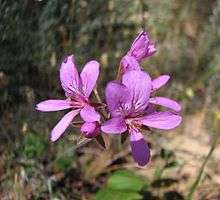Pelargonium rodneyanum
| Pelargonium rodneyanum | |
|---|---|
 | |
| Scientific classification | |
| Kingdom: | Plantae |
| (unranked): | Angiosperms |
| (unranked): | Eudicots |
| (unranked): | Rosids |
| Order: | Geraniales |
| Family: | Geraniaceae |
| Genus: | Pelargonium |
| Species: | P. rodneyanum |
| Binomial name | |
| Pelargonium rodneyanum Lindl.[1] | |
Pelargonium rodneyanum, commonly known as magenta storksbill, is a perennial herb species that is endemic to Australia. It grows to 40 cm high and has leaves with 5 to 7 shallow lobes.[2] Dark pink flowers appear between October and February in the species native range.[3]
The species was first formally described in 1838 by English botanist John Lindley in the second volume of Thomas Mitchell's Three Expeditions into the interior of Eastern Australia.[1]
It occurs on rocky slopes in forested areas of New South Wales, Victoria and South Australia.[2]
In cultivation, the species prefers a sunny position with good drainage. It tolerates a variety of soil conditions as well as periods of dryness and frost. It is suited to rockeries and can be grown in containers.[4]
References
- 1 2 "Pelargonium rodneyanum". Australian Plant Name Index (APNI), IBIS database. Centre for Plant Biodiversity Research, Australian Government, Canberra. Retrieved 6 November 2011.
- 1 2 "Pelargonium rodneyanum". PlantNET - New South Wales Flora Online. Royal Botanic Gardens & Domain Trust, Sydney Australia. Retrieved 6 November 2011.
- ↑ Wild Plants of Victoria (database). Viridans Biological Databases & Department of Sustainability and Environment. 2009.
- ↑ Greig, D. (1987). The Australian Gardener's Wildflower Catalogue. Australia: Angus & Robertson. ISBN 0207154600.